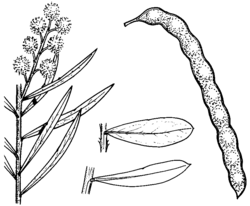Common name: western silver wattle, showy wattle
Acacia decora Rchb. APNI* Synonyms: Racosperma decorum (Rchb.) Pedley APNI*
Acacia caleyi A.Cunn. ex Benth. APNI*
Acacia buxifolia var. decora (Rchb.) C.W.Moore & Betche APNI*
Acacia decora var. biglandulosa Domin APNI*
Acacia decora var. macrophylla T.Mitch. APNI*
Acacia decora var. typica Domin APNI*

Description: Erect or spreading shrub usually 1–4 m high; branchlets ridged, reddish brown, at first appressed-hairy, glabrescent.
Phyllodes narrowly elliptic to oblanceolate or obovate, ± straight or slightly curved, 1.5–5 cm long, usually 2–7 mm wide, subglaucous, glabrous, midvein prominent, lateral veins obscure or faint, apex acute or obtuse with a mucro; 1 or 2 glands with lowermost usually 5–15 mm above pulvinus; pulvinus < 2 mm long.
Inflorescences mostly 5–15 in an axillary or terminal (rarely indefinite) raceme; axis 2–6 cm long; peduncles 5–8 mm long, usually golden appressed-hairy; heads globose, 15–30-flowered, 4.5–6 mm diam., bright yellow.
Pods usually straight to shallowly curved, ± flat, ± straight-sided to slightly constricted between seeds, 5–10 cm long, 4–7 mm wide, firmly papery to thinly leathery, glabrous, sometimes ± pruinose; seeds longitudinal; funicle filiform.
Flowering: usually April–October.
Distribution and occurrence: widespread through much of central part of the State, west to the Cobar district, with a dubious record from Menindee Lakes (SFWP). Grows in dry sclerophyll forest and open situations in woodlands (including Mallee, Callitris and Box woodlands), scrub and grasslands, often in heavy soils or sandy loams, on rocky or stony hillsides, ridges, undulating country and red soil plains. Where extensive clearing has occurred, it may only remain in remnant vegetated areas.
NSW subdivisions: NC, CC, NT, CT, ST, NWS, CWS, SWS, NWP, SWP, ?SFWP
Other Australian states: Qld Vic.
The name refers to the decorative appearance of the species. It is very variable, particularly in phyllode shape, with several forms which also intergrade. Plants with ± linear phyllodes, commonly 1–2 mm wide, occur in the Hunter River area. A localised variant in the Griffith area is sometimes recognised as Acacia caleyi A.Cunn. ex Benth.; it is distinguished by ± spreading, often curved or crisped hairs on its branches and raceme axes.
Text by P.G. Kodela (last updated May 2012)
Taxon concept: P.G. Kodela & G.J. Harden, Flora of NSW Vol. 2 (2002)
APNI* Provides a link to the Australian Plant Name Index (hosted by the Australian National Botanic Gardens) for comprehensive bibliographic data
***The AVH map option provides a detailed interactive Australia wide distribution map drawn from collections held by all major Australian herbaria participating in the Australian Virtual Herbarium project.
|


